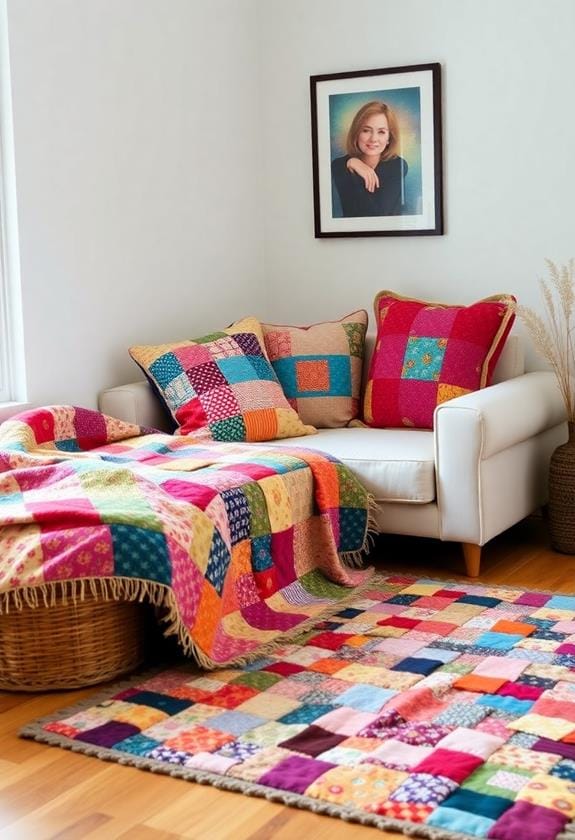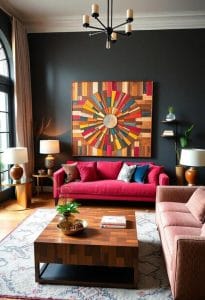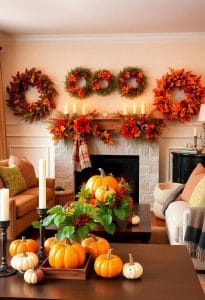Transform your home with creative DIY projects using fabric scraps. Start with vibrant patchwork cushions by sewing assorted fabric squares together for a striking effect. Consider crafting fabric scrap wall art by arranging colorful pieces on a canvas, attaching them with fabric glue or sewing for depth. Handmade fabric bunting can add playful charm, while upcycled fabric planters bring a textured look to your greenery. Unique fabric coasters and quilted table runners offer style and function, utilizing even the smallest scraps. These projects not only personalize your space but also support sustainable practices, enhancing your home decor with creativity and flair. Explore further to discover an array of ideas.
Key Points
- Create fabric scrap wall art by arranging and gluing scraps onto a canvas for a unique visual display.
- Sew colorful patchwork cushions by assembling fabric squares into a vibrant front and attaching to a cushion backing.
- Design handmade fabric bunting with triangle or rectangle scraps affixed to a ribbon for decorative hanging.
- Upcycle fabric scraps into planters by gluing them onto containers and sealing for durability.
- Make unique fabric coasters by layering and sewing fabric pieces into uniform shapes for a stylish table accessory.
Fabric Scrap Wall Art
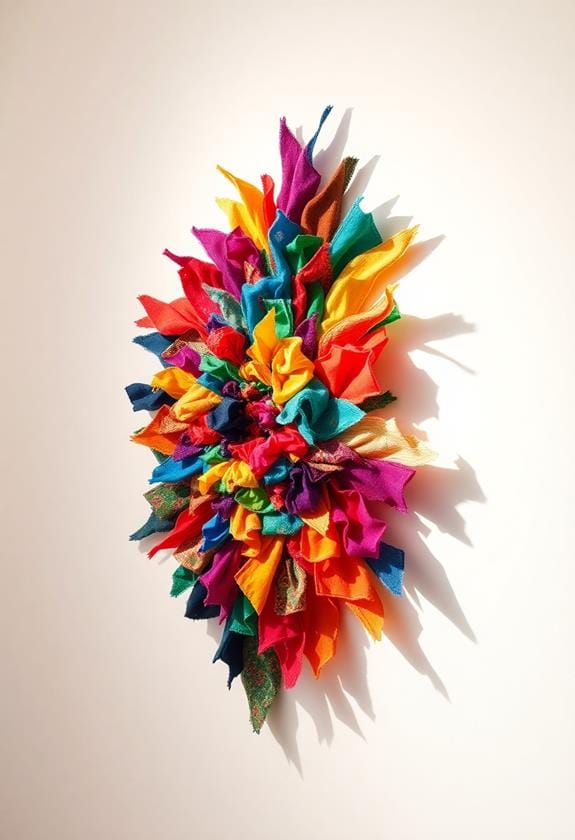
Transform your leftover fabric scraps into stunning wall art with a bit of creativity and a few simple steps. Start by gathering a variety of fabric pieces—different textures and colors will add depth to your creation. For more inspiration, consider checking out home decor creations that utilize fabric scraps. Choose a base for your art, like a canvas or a wooden board, which you can easily find at craft stores. Lay out your fabric pieces on the base, experimenting with different arrangements until you find a composition that feels balanced and appealing.
Next, decide how you want to attach the fabric to the base. You can use fabric glue for a quick and easy option, or sew the pieces in place for a more textured look. If sewing, verify your needle is sharp and strong enough to handle multiple layers. Once you're satisfied with the layout, start fixing each piece securely, being careful to smooth out any wrinkles for a polished finish.
Colorful Patchwork Cushions
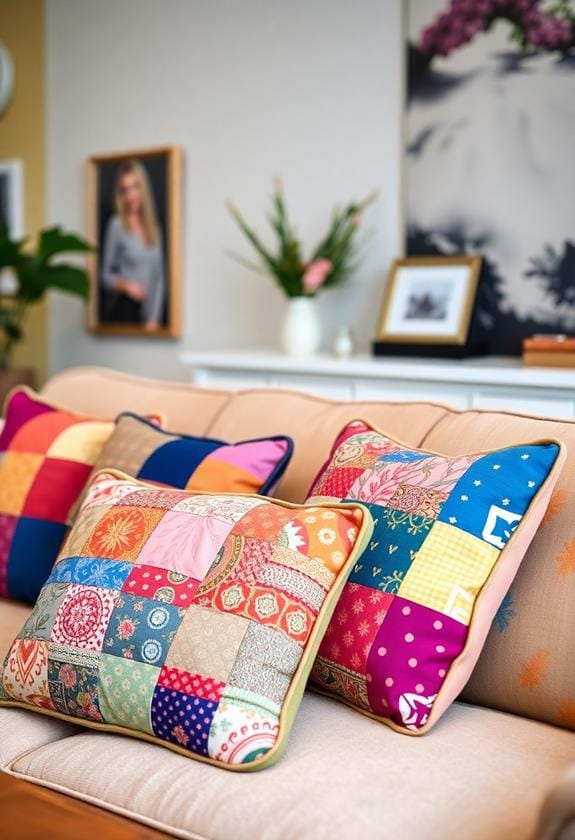
Creating colorful patchwork cushions is a delightful way to add a splash of personality to any room. You can transform leftover fabric scraps into unique, cozy additions to your home decor. Start by gathering a mix of fabric pieces, ensuring a variety of colors and patterns to create visual interest. The beauty of patchwork is in its diversity, so don't worry about matching too perfectly. For more inspiration, explore DIY home decor ideas specifically tailored for small spaces.
Here's a simple approach to making your own patchwork cushion:
- Cut and Arrange: Cut your fabric scraps into uniform squares or rectangles. Lay them out in your desired pattern, experimenting with different arrangements until you're satisfied.
- Sew the Pieces: Begin sewing your pieces together, row by row. Press the seams open with an iron to keep everything flat and neat.
- Assemble the Cushion: Once your patchwork front is complete, attach it to a backing fabric, leaving one side open. Turn it right-side out, insert a cushion insert, and sew the opening closed.
With these cushions, your space gains warmth and character. It's a perfect project for a weekend afternoon, allowing you to showcase your creativity and make use of those fabric scraps you've been saving.
Handmade Fabric Bunting
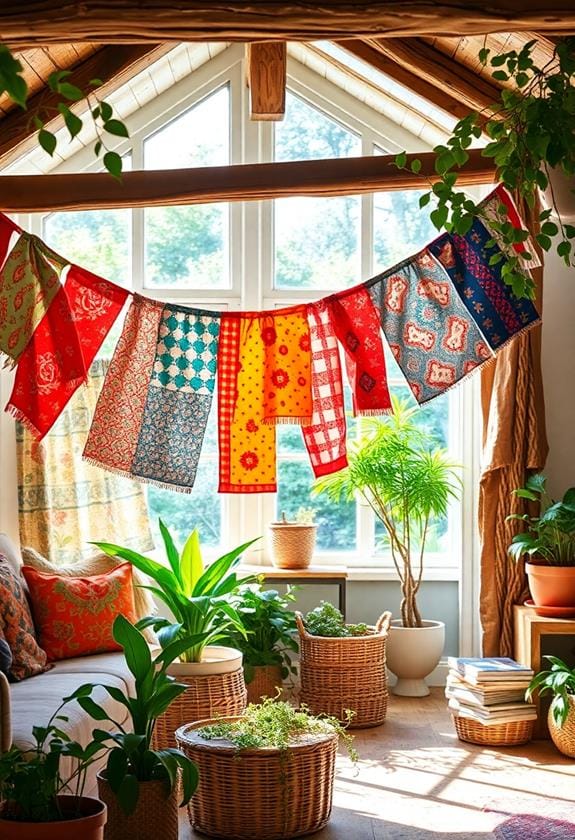
Often seen at festive events, handmade fabric bunting can effortlessly bring charm and whimsy to your home decor. You can create these delightful garlands using fabric scraps, transforming them into vibrant displays of color and texture. Start by gathering a variety of fabric pieces, ensuring they complement your existing decor or event theme. Consider browsing quick DIY home decor transformations for inspiration on how to match your fabric selections with your existing space. Cut the fabric into triangles or rectangles, depending on your preference, and decide on the size that suits your space best.
Next, sew or glue the fabric pieces onto a ribbon or strong string, leaving enough space between each piece to allow them to drape naturally. If you prefer a more uniform look, consider using a sewing machine for even stitching, but don't worry if you're new to sewing; hand-stitching or fabric glue works perfectly too. Experiment with different patterns and textures to create a unique look that reflects your personal style.
Hang your fabric bunting along walls, across windows, or above doorways to instantly uplift any room. The playful movement of the fabric in the breeze adds a dynamic element to your decor, making your space feel lively and inviting. Enjoy the process, and let your creativity shine!
Upcycled Fabric Planters
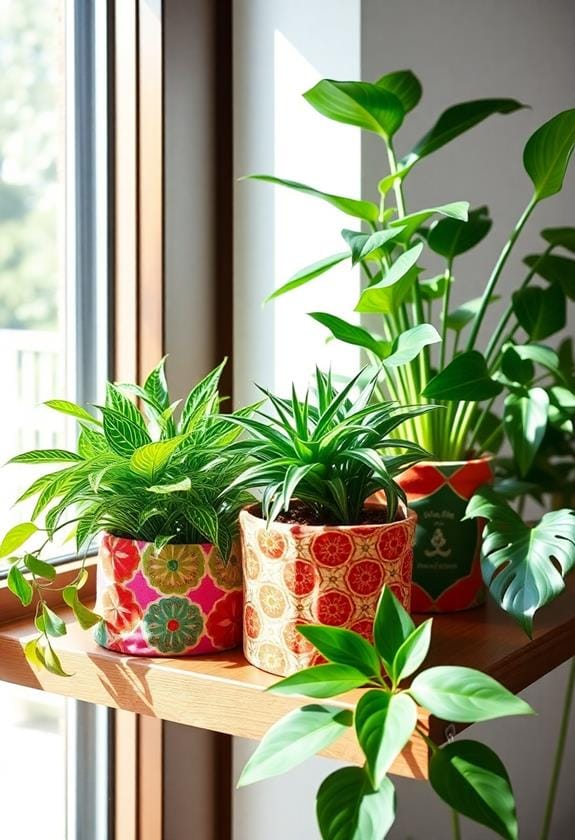
Many fabric scraps can find a new purpose as charming upcycled fabric planters. These planters add a splash of color to your home, offering a creative way to showcase your favorite plants. To start, gather fabric scraps you love and follow these simple steps to craft your own planter.
- Choose Your Container: Select a pot or jar that suits your plant's needs. Consider the size and shape, guaranteeing it fits well with the space you have in mind. Clean it thoroughly to prepare it for its fabric makeover.
- Cut and Assemble: Measure and cut your fabric scraps to fit your container snugly. Mix and match patterns or stick with a cohesive theme, depending on your style. Use fabric glue or a hot glue gun to securely attach the fabric to your container, making sure there are no loose edges.
- Finish with a Protective Sealant: To guarantee durability, apply a clear sealant over the fabric. This step protects your planter from water damage and keeps it looking vibrant.
Unique Fabric Coasters
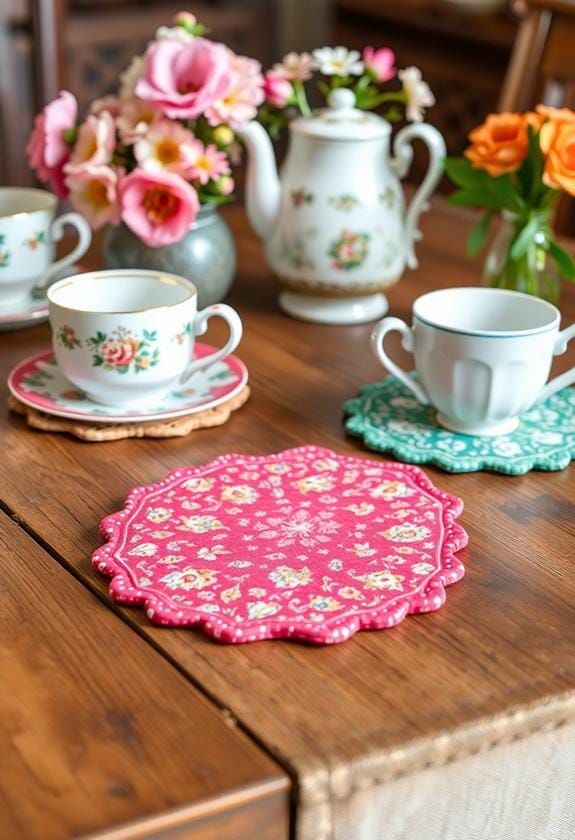
Transforming a few fabric scraps into unique coasters is a delightful way to personalize your home decor while protecting your surfaces. Start by gathering colorful scraps that complement your existing decor. You'll need a few basic supplies: scissors, needle and thread, or a sewing machine if you prefer. Cut your fabric into uniform squares or circles, about four to five inches across. This size is ideal for most cups or mugs.
Next, layer two fabric pieces with the patterned sides facing out. You can add a thin layer of batting between them for extra absorbency. Sew around the edges, leaving a small gap. Turn the fabric inside out through this gap, ensuring the pattern is visible on both sides. Once flipped, stitch the gap closed with a neat finishing seam. If you're looking for more affordable DIY home decor ideas, consider using leftover materials to create matching napkin rings or placemats.
For added flair, consider using contrasting thread for a decorative border stitch or adding small embellishments like buttons. These coasters aren't just practical; they're conversation starters, showcasing your creativity. Plus, they're machine washable, making maintenance a breeze. With these personalized coasters, you're not only recycling fabric but also adding a handmade touch to your living space.
Quilted Table Runners
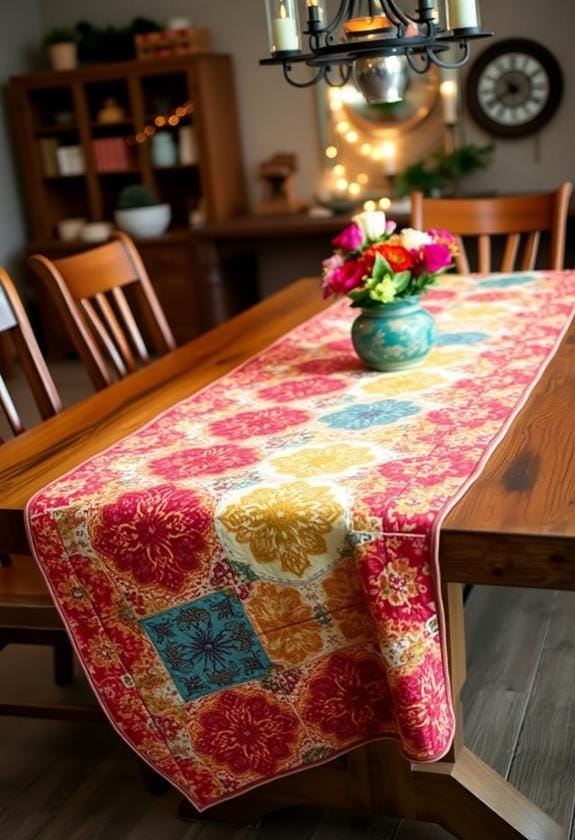
After crafting your unique fabric coasters, why not elevate your table setting with a quilted table runner? It's a charming way to showcase your creativity and add a personal touch to your dining area. Start by gathering your fabric scraps, guaranteeing you have a variety of colors and patterns. This will give your table runner a vibrant and eclectic look. Keep in mind that mixing different textures can add depth and interest, similar to embroidery hoop displays. Here's a simple way to create your quilted table runner:
- Cutting and Arranging: Cut your fabric scraps into uniform squares or rectangles. Arrange them in a pattern that appeals to you. Mixing different textures can add depth and interest.
- Sewing the Pieces: Sew the pieces together row by row, using a quarter-inch seam allowance. Press the seams open to guarantee a flat finish. Once all rows are finished, sew them together to form a complete runner.
- Quilting and Binding: Layer your quilt top with batting and backing fabric. Quilt through all layers in a design of your choice. Finally, bind the edges neatly to complete the piece.
This project not only enhances your table but also uses up those leftover scraps, making it both stylish and sustainable.
Frequently Asked Questions
How Can I Prevent Fabric Scraps From Fraying When Cutting?
Cut cleanly to curb fraying by opting for pinking shears, which create zigzag edges that discourage unraveling. You can also apply a thin layer of fabric glue along the edges, forming a fray-free finish. Another option is to use a serger, which neatly trims and seals edges simultaneously. For a no-sew solution, consider using an iron-on adhesive tape to bind the fabric edges, providing a polished look without stitching.
What Tools Are Essential for Working With Fabric Scraps?
When working with fabric scraps, you'll need a few essential tools to guarantee precision and ease. A sharp rotary cutter makes cutting quick and accurate, while fabric scissors are key for detailed trimming. You'll also want a cutting mat to protect surfaces and a ruler for measuring. Pins or fabric clips help hold pieces together, and an iron is important for pressing seams. These tools will make your crafting experience smoother and more enjoyable.
Where Can I Find Free Fabric Scrap Project Patterns?
Finding free fabric scrap project patterns is as satisfying as discovering hidden treasures. You can explore websites like Pinterest and Craftsy, which offer a wealth of creative ideas. Local library resources and online forums also provide patterns, often shared by fellow enthusiasts. Don't overlook social media groups dedicated to sewing; they're brimming with generous members who love sharing their finds. With a little digging, you'll uncover numerous inspiring projects.
How Do I Properly Store Leftover Fabric Scraps?
To store leftover fabric scraps properly, start by sorting them according to size and type. Use clear bins or labeled boxes, which make it easy to find what you need later. Folding or rolling scraps helps maximize space, and using small ziplock bags for tiny pieces can keep them organized. Consider a dedicated storage space, like a drawer or shelf, to guarantee your scraps are both accessible and neatly contained, preventing clutter.
Can Fabric Scraps Be Used to Create No-Sew Decor Items?
Absolutely, you can use fabric scraps to create no-sew decor items. Start by considering simple projects like fabric-wrapped vases or picture frames. Cut strips of fabric, then use glue or double-sided tape to adhere them to the surface, creating a vibrant, textured look. You can also make fabric garlands by knotting strips onto a string. These projects are quick, cost-effective, and add a personal touch to your space without sewing skills.

